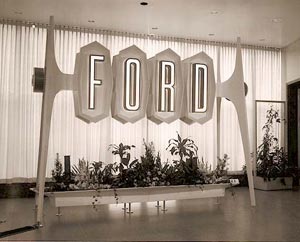
The Styling Studio entrance in 1961
Mr. J.J. Telnack, former Vice President of Corporate Design, for Ford
Motor Company said, “Phil was one of our most talented designers and was
part of the original Mustang design team throughout its development in 1962
until it’s launch. He had considerable influence on the total design with
the early prototype Mustang concept vehicle that he [Clark] directed"
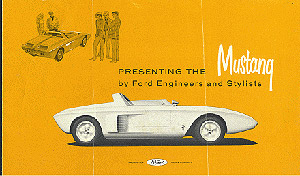
Did you ever notice the curious
Mustang sign on the 1962 Mustang I promo truck and in the related sales
literature.
There is more behind it, it's designed by Clark and shown on his early Mustang
sketches.
We've heard in 2007 about such a Mustang sign on the market being used
either in the truck or as a signpost for the Mustang I show.
The Main Players around the
Mustang I
Eugene Bordinat - Design Head
A. Exterior Design
Bob Maguire - Chief Stylist
John Najjar - Executive Stylist
Phil Clark - Senior Designer (Mustang I Project/Pony Emblem)
Jim Darden - Assistant
Ray Smith - Design Studio Engineer
John Cecil, Bonnie Flores - Modeller
B. Interior Design
Damon Woods - Chief Stylist
Jim Sipple - Design Executive Stylist
Jim Quinlan - Mustang 1 Design Manager
C. Others
J.J. Telnack Chief Designer
Lincoln Mercury (later boss of Phil)
Herb Misch - Chief Engineering
Roy Lunn - Chassis Engineer
CB Anderson - Transmission and Chassis Division
G. Bern, Al Haynes, Bt. Howes - Engineering staff
Bob Negstad - Chassis engineer
Chuck Carrig - Programmer
Len Bailey - Assistant
Chuck Mountain - Assistant
Ed Hull - Assistant
Wh. Gay and Wd. Innes - Engine and Foundry Division
RW Smith Transmission and Chassis Division
Cr. Briggs - Engineering Public Relations
John P. Breeden - Stylist Public Relations
In most publications John Najjar
gets the credit for the Mustang I. Here is what he himself said in various
interviews.
Read
from a 1997 article, published on www.theautochannel.com
"One of the designers was John Najjar, now retired after a career with
Ford going back to the late '30s.
"We had a studio under Bob Maguire,"
Najjar explains, "and in it were Jim Darden, Ray Smith, plus an artist, Phil
Clark, several modelers, and me.
We drew up
a 2-seater sports car in competition with the other studios, and when they saw ours
- saw
the blackboard with a full-sized layout and sketches- they said, 'That's it!
Let's build it.'
So we made a clay model, designed the details, and then built a
fiberglass prototype." This car was simply a concept study rather than the
final configuration, but it included a lot of the sporty, rakish flair the later
showcar embodied."
The full Najjar interview can be read here
More from David Ash and others
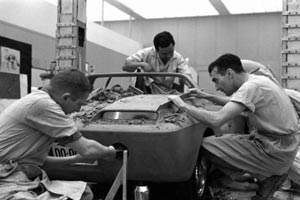
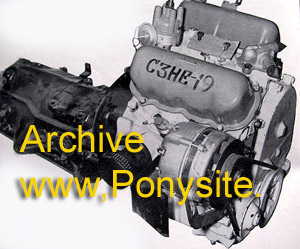
The V-4 came from the Cardinal project that
was stopped in Ford Germrany. Note the code C3HB-19 on the final engine used
for the Mustang I
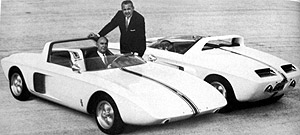
The driveable prototype and the claymodel with the decal-like Di-Noc film
treatment next to each other.
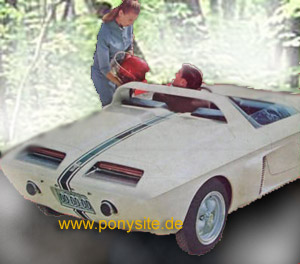
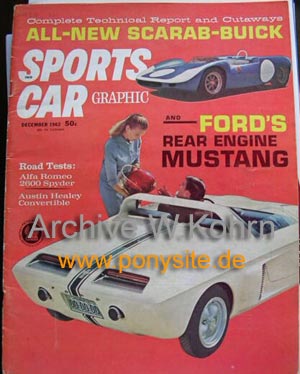
Sports Car Graphic and Auto Sports amongst others did articles on the Mustang I.
A variety of these mags serves us in further research.
The Ford Benson Research Center has been contacted
quite often in the past year for research on Phil Clark. Now count your
fingers again.
The original interviews from David Crippen with various Ford designers in
the 80ies have been accurately documented. Hundreds of pages of notes are
available of these interviews for our ongoing research.
|
The birth of the Mustang I
was not in 1962
as we believed for a long time.
Let's dive into Phil Clarks Styling Center environment, work and scetches.

16 Stylists worked in the Ford Advanced Vehicles Studio. Roy
Lunn and a few more engineers are pictured here as well. Clark is m.p. pictured as
the 3rd from left. Note the Mustang writing, that is a part of Clarks first
Mustang Pony emblem!
Holly Clark recalls the facts about her dad's start at Ford Motor Company:
- Dad got on the wrong side of a GM exec....
- Dad was fired from GM after 8 or 9 months in March
1962.
- Even before mom and dad could lose their apt in Detroit... Ford hired
dad... they were looking for a new sports car...
- Dad came to Ford in early April with the complete MUSTANG
idea...
- It was accepted in late April 1962..and continued to be accepted up the ladder of Ford
Design.
- Then came the time for a name for the car... and the emblem. Several
names were thrown out for the car... and the emblem ideas..and names were
projected by transparency on a wall for the executives ..
- It was unanimous: They liked the "horse"... and then
said..So how do we know this is an AMERICAN HORSE?
Dad got up.. and with Red White
& Blue Marker colored in his lines behind the horse... Red/White/
Blue.. (This was confirmed by eye witnesses)
It was accepted.... the Prototype was on!
The affordable sports car was not going as planned, but the
promotion for the Mustang I Prototype was creating the hype expected.. Therefore
the redesigned Falcon..of 64 1/2 (Cougar study)... was released with the MUSTANG and the
Emblem and a
few other oddities. of the prototype... dad continued to work on the
Mustang design...but he JUST got to FORD...so HIS other MUSTANG
designs..didn't come out until later years after the finish of his
FIRST Mustang design.....

Let's dive a bit into the accurate timeline of the Mustang I
28th. April 1962- Phil
Clarks designs with his signature on them are pinned on the wall behind Najjar during a presentation.
Bordinat and Maguire like the designs. Bordinat says: "Go play, guys"
Dan Guerney indeed visits the studio later, but the decison was already made
by Gene Bordinat.
9th. May 1962 - work started on the clay
model. Troutman & Barnes gets involved the same day
24th.
May 1962 - Work starts at
T&B
25th. May 1962 - The finished clay
model is photographed in the Ford Studio
31st. May 1962 - The drawings for
the prototype exterior are finished
4th. June 1962 - Approved drawings
are given to T&B
23rd Aug. 1962 -
last mechanical component shipped to T&B
18th. Sept. 1962 - The V-4 engine is
delivered to T&B
21st. Sept. 1962 - The rear
transaxle is delivered to T&B
23rd. Sept. 1962 - Ford Styling
delivers the painted and taped Body
26th. Sept..1962 - The chassis is
finished
27th. Sept. 1962 - the drivable
prototype is photographed in the studios
2. Oct. 1962 - the Mustang I is
presented to the management
7th. Oct. 1962 - The Mustang I is
presented to the public at the Watkins Glen United States Grand Prix. Dan
Guerney and Stirling Moss drive the prototype around the race course.
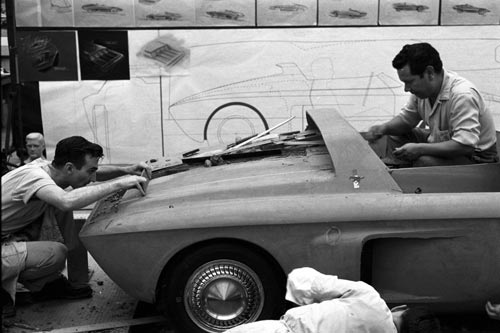
Take a closer look at the wall behind the clay
modeller.
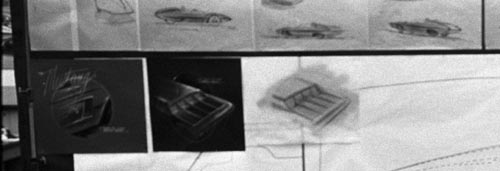
There you see all the designs and renderings
produced by Phil Clark.
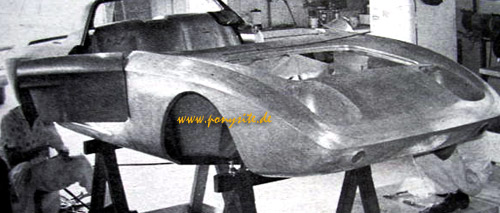
Troutman
and Barnes employees, Culver City/CA at work on the alum body of the Mustang
I.
T&B, a custom car builder, was ordered working along the drawings and
design under Roy Lunn (Chassis) and Phil Clark (Design) and shape the lines
according to the drawings and designs into reality. T&B was involved into
the project very early on.
The finished chassis development (started by Roy Lunn on May 9th and
transferred to Troutman 2 weeks later was not pictured in the studios before
Sept. 27th. 1962.)
Pictures Archive Ponysite.de
A Mystery sketch in Clarks portfolio and published in a Motorcade magazine
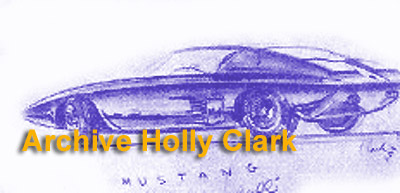
Was this sketch
produced in May 1958 or on May 28, 1962?
You'll be the judge.
If it was 1958, then
it's clear Phil had a vision of his car already in the Art Center School of
Design. Classmates confirm that he was drawing car designs with the name
Mustang throughout his
scholarship there.
If it is May 28, 1962, then it was clearly a design derivating from the
Mustang I, a vision of a possible fastback version of the open
2-seater. This was an objective already before the development started,
although it was supposed to be clearly a show car only.
Phil Clark never left away the year in
his sketches, so a May 28,1962 date without a year was really untypical for him.
People having closely examined his writings including his wife and daughter
confirm that this must be a 58 instead of a 28. See below a close up and
another date code from Phil on another Mustang drawing in 1962. Why should he
use 2 different writings in such a short period of time?
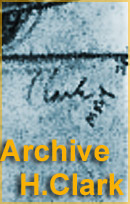

This design sketch of that fastback roofline got published in a
Motorcade mag in fall 1963. Some would say from the timeline of the Mustang I history...
May 28 would be alright for 1962, since the prototype of the open
2-seater was started 9th. of May, but then again here are some additional arguments:
1) If you look at another date handwritten by Clark, look at the 5 and
the 2.
2) Clark used to write earlier just a month and a 2 digit year during
school on his drawings, later he sometimes used the complete date code
writing like 5-1-62.
3) Acc.
to school mates
Clark was doing Mustang designs already at the Design Center Art School of his visionary
car,
so much earlier than we knew before and noticeable earlier before his Ford job.
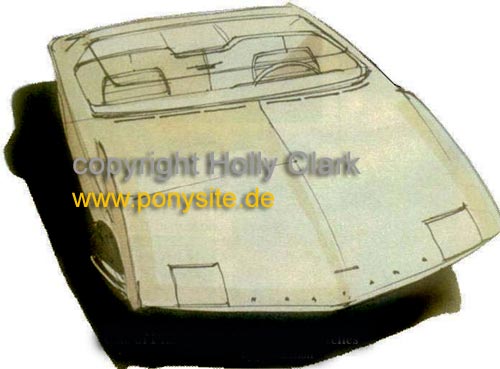
Note the letters on the front hood
and the sign between the seats - an early
design of Clark
4) Designs cannot simply be taken home at Ford, these designs were
stored in folders that Clark used for getting a job with his designs.
5) He send them to Chrysler, AMC, GM and others, but was turned down
by Chrysler first and asked to
go to Art School, says Holly. Holly has variations of 2+2 sports cars and
2-seater sketches in her files, tame and wild horses drawings, Mustang
sublined designs etc..
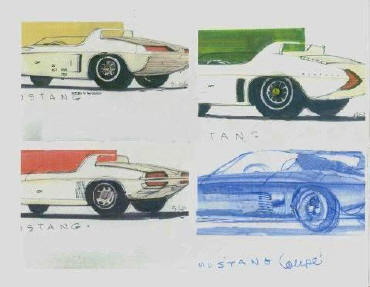
Some of the designs Holly has in her files predate May 1962, when the
prototype was started, says Holly.
The upper show a May 1st, 62 date.
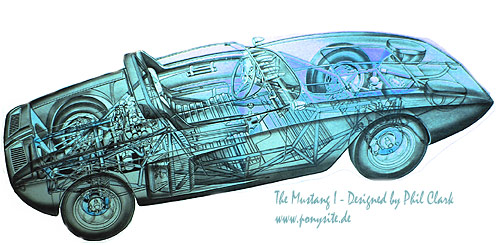
An early 1962 explosion view illustration - courtesy
illustrator Bob Thatcher.
"Unveiled
in 1962, this concept started development of what became the four-time Le Mans
winning Ford GT40"
Quote from Ford's own website!
Read more
|

















